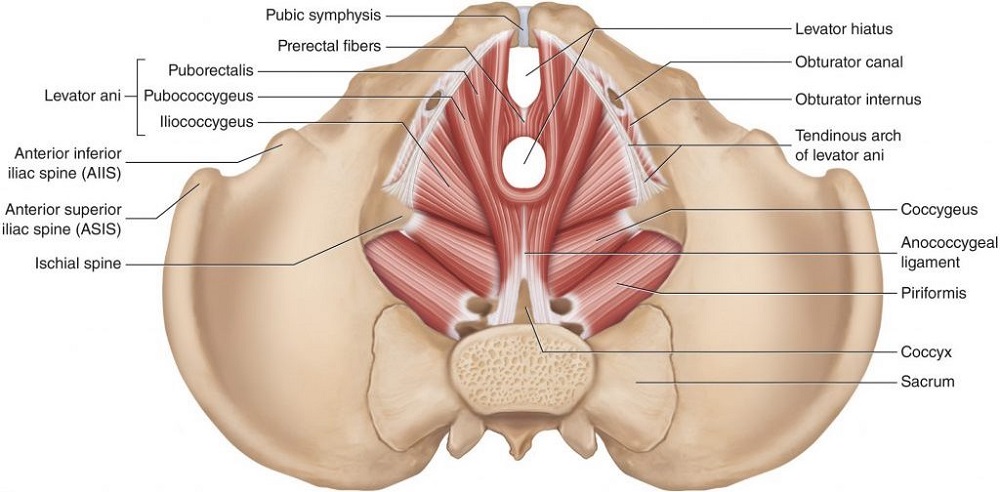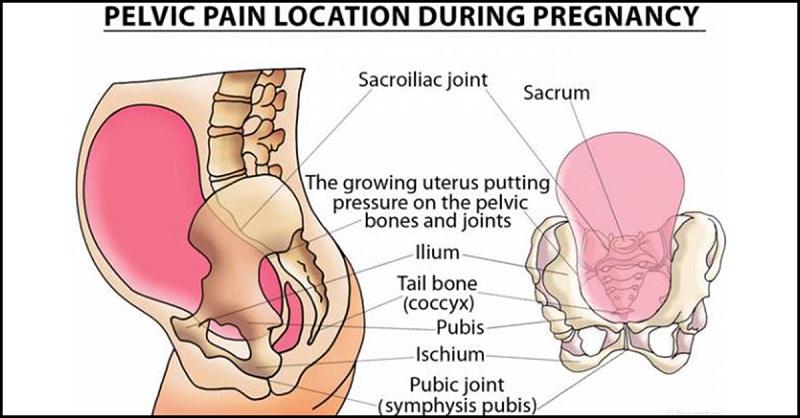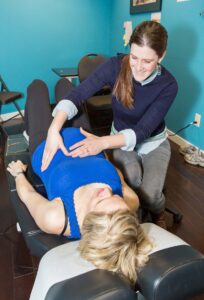Chiropractic Care and the Pelvic Floor
The pelvic floor plays an important role in women’s (and men’s) health. It serves as the floor of your core and influences everything from peeing and pleasure to breathing and having a baby.
Pelvic Floor Dysfunction (PFD) is a complex process that usually develops secondarily to a diverse set of circumstances or triggers. It is a term that refers to a broad range of clinical scenarios, including incontinence (both urinary and anal), overactive bladder, pelvic organ prolapse, and sexual disorders. The physical and emotional impacts of these struggles cannot be overstated!
It is very common for women to experience PFD following pregnancy and the birth of a child. In fact, there are several factors about your birth experience that may increase your risk of PFD, such as mode of delivery, use of forceps, interventions including episiotomy, size of baby, and BMI prior to and during pregnancy. There is always some stress and healing involved for the pelvic floor following pregnancy and delivery (regardless of mode), but that does not mean that there is supposed to be symptomatic and lasting dysfunction. Remember, ‘common’ does not equal ‘normal’ or ‘ideal’! Just because your friend Suzy pees when she skips does not make it OK.
So what do you do about it? Or how do you prevent PFD altogether?
I would love if we always had the opportunity to start working with moms during their preconception preparations to support building a resilient body prior to baby. If this is you, work on those modifiable risk factors. Achieving a healthy BMI prior to pregnancy would eliminate a risk factor for PFD. In general, a healthy core and overall state of fitness are going to help you along your journey as well.
Please do not misunderstand me here. Athletes and fit-mamas can have PFD too! Quite often there will be compensation patterns of too much or too little tone in the pelvic floor muscles, so checking in with a pelvic floor physiotherapist during this stage can provide valuable insight.
If you are in the pregnant stage, staying active and maintaining a healthy weight are still important. It would also be wise for you to educate yourself on birth interventions and their impact on PFD. Talk with your maternity provider and make sure that your birth preferences are clearly understood.
Are you at the postnatal stage, which is where most moms begin their awareness of the impact of their pelvic floor on their daily life? Exercise-based postnatal rehab plays an important role in recovery, regardless of mode of delivery. Find an experienced postnatal practitioner (likely a pelvic floor physiotherapist) or team of providers to guide you through.
Chiropractic Care and the Pelvic Floor
There have been some interesting investigations in that last few years looking at the impact of spinal adjustments of the pelvis on the function of the pelvic floor muscles.
In one small study4, they compared the capacity to appropriately contract and relax pelvic floor muscles in both pregnant and non-pregnant women using ultrasound imaging. Levator hiatal area measurements at rest, on maximal pelvic floor contraction, and during maximum Valsalva manoeuvre were recorded before and after either spinal manipulation or a “sham” intervention. The most notable finding was that levator hiatal area at rest increased significantly after spinal manipulation in the pregnant women. This improved capacity to relax pelvic floor muscles may be beneficial during vaginal delivery, suggesting that chiropractic care may be beneficial for pregnant women who are not naturally relaxing their pelvic floor muscles efficiently.
A surprise finding in this study was that the non-pregnant control group made out of female chiropractic students was able to achieve measurements on Valsalva that had previously only been recorded in elite athletes9. The researchers hypothesized that this finding was due to the fact that these women were likely adjusted on a regular basis, which increases phasic perineal contraction and basal perineal tonus… which we will explore in the next study.
Another earlier study13 had looked at quantifying intravaginal pressure and basal perineal tonus before and after an adjustment of the sacrum in non-pregnant women. They found that both of these measures increased after spinal manipulation.
It is not a very large leap to come to the conclusion that the relationship of the pelvic bones would impact the function of the pelvic muscles. Even from the most mechanistic view, when there are more ideal positioning and symmetry, the “pullies and leavers” work better.
What is interesting when you compare the findings of both of these studies is that they demonstrate a “normalization” of pelvic floor function. Improvements in the capacity to relax AND the capacity to contract efficiently were noted. This improved muscle coordination is not likely due to improvements in the static structure of the pelvis. Previous studies have shown an impact of spinal manipulation on motor control8,11,12, core muscle contraction timing11, intracortical (brain) facilitation and inhibition3, lower recruitment threshold of motor neurons 12, reduced fatigue 12, and an increase in maximal voluntary muscle contraction of the lower limb12.
All that fancy science to say that the improved function of the pelvic floor noted in these preliminary studies is most likely due to the impact that an adjustment has on the nervous system.
So, you ask, if I haven’t lost you yet, what is my point?
Pelvic floor function is important for overall health and perinatal experience. Pelvic floor dysfunction is a real pain in the whoo haa. If you have any symptoms, any concerns, or are just plain curious, I strongly encourage you to check in with a qualified and experienced women’s health professional.
Chiropractic care is a commonly sought after conservative treatment option for low back pain and pelvic girdle pain during pregnancy. Previous studies have shown a positive trend in clinical response. It is possible, given the dynamic nature of reflexive core function (trunk stabilization) and the prevalence of Stability/Motor Control Dysfunction (SMCD) in this population, that part of the previously reported benefits in pain management may have been due to enhanced motor control of the pelvic floor.
There have been many reported health benefits of chiropractic care. The influence of an adjustment on core and pelvic floor function may be one of the reasons why we see such a positive influence on low back and pelvic girdle pain during pregnancy 2,10, as well as potentially improved outcomes during labour.
SMT (spinal manipulative therapy) may be supportive for pelvic floor dysfunction (PFD), but is certainly not the sole treatment. We recommend using SMT from a perinatally-focused chiropractor as a supportive technique for PDF in conjunction with pelvic floor physiotherapy.
These studies also have interesting implications for supporting moms as they prepare for the big day. Supporting ideal biomechanical and neurological function in the core and pelvis help mom feel more comfortable and confident as she enters into labour and may actually facilitate the capacity to relax the pelvic floor in a way conducive to “damage-free” delivery.
REFERENCES & RESOURCES
- Bozkurt M et al. Pelvic floor dysfunction, and effects of pregnancy and mode of delivery on pelvic floor. Taiwanese Journal of Obstetrics & Gynecology. 53 (2014) 452-458.
- Diakow PR, Gadsby TA, Gadsby JB, Gleddie JG, Leprich DJ, Scales AM. Back pain during pregnancy and labor. J Manipulative Physiol Ther 1991;14(2):116-8.
- Haavik Taylor H, Murphy B. Transient modulation of intracortical inhibition following spinal manipulation. Chiropr J Aust 2007;37:106-16.
- Haavik H et al. Effect of spinal manipulation on pelvic floor functional changes in pregnant and nonpregnant women: a preliminary study. JMPT (2016) 39:5.
- Haavik Taylor H, Murphy B. Altered sensorimotor integration with cervical spine manipulation. J Manipulative Physiol Ther 2008;31(2):115-26.
- Haavik Taylor H, Holt K, Murphy B. Exploring the neuromodulatory effects of the vertebral subluxation and chiropractic care. Chiropr J Aust 2010;40(1):37-44.
- Haavik Taylor H, Murphy B. Cervical spine manipulation alters sensorimotor integration: a somatosensory evoked potential study. Clin Neurophysiol 2007;118(2):391-402.
- Haavik H, Murphy B. The role of spinal manipulation in addressing disordered sensorimotor integration and altered motor control. J Electromyogr Kinesiol 2012;22(5):768-76.
- Kruger J, Dietz H, Murphy B. Pelvic floor function in elite nulliparous athletes. Ultrasound Obstet Gynecol 2007; 30(1):81-5.
- Lisi AJ. Chiropractic spinal manipulation for low back pain of pregnancy: a retrospective case series. J Midwifery Womens Health 2006;51(1):e7-e10.
- Marshall P, Murphy B. The effect of sacroiliac joint manipulation on feed-forward activation times of the deep abdominal musculature. J Manipulative Physiol Ther 2006; 29(3):196-202.
- Niazi I, Türker K, Flavel S, Kinget M, Duehr J, Haavik H. Changes in H-reflex and V waves following spinal manipulation. Exp Brain Res 2015;233(4):1165-73.
- Nogueira de Almeida BS, Sabatino JH, Giraldo PC. Effects of high-velocity, low-amplitude spinal manipulation on strength and the basal tonus of female pelvic floor muscles. J Manipulative Physiol Ther 2010;33(2):109-16.





